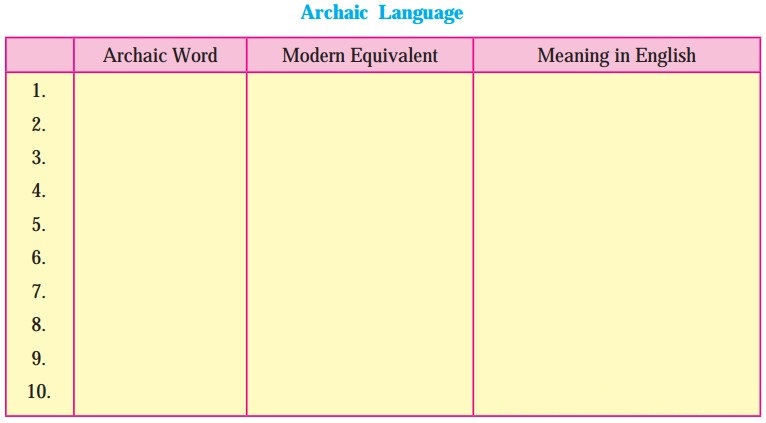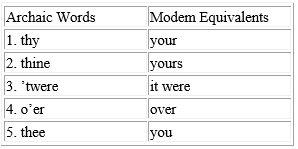Chapter 4.5 Tansen
Chapter 4.5 Tansen
Textbook Questions and Answers
Warming Up:
Question (a)
Indian Classical Music consists of many Ragas. Find out from an expert or from the internet, the names of at least 10 Ragas and the time they are sung to produce greater effect.
Answer:

(Students can find more information from the Internet.)
Question (b)
Archaic words are those that are no longer used in a language, but sometimes their usage adds a historical or old-times flavour to a piece of writing.
Examples:
- behold – look
- afeared – frightened
- forsooth – indeed
- hither – this place
Now find out some archaic words from your mother tongue or another language that you are proficient in and write down at least ten of them, and against each, their modern equivalent and meaning in English.
Answer:

(Students can find out from their parents or other elders, and attempt this in their own mother tongue.)
Question (c)
There are many legends about the ‘nine gems’ in Akbar’s Court. Can you name some of the nine gems and the stories associated with them?
Answer:
The nine gems of Akbar’s court were:
- Abu’l Fazi ibn Mubarak
- Raja Todar Mai
- Abdul Rahim Khan-i-Khana
- Raja Birbal
- Mulla Do-Piyaza
- Faizi
- Fakir Aziao-Din
- Tansen and
- Raja Man Singh I.
There Eire plenty of Akbar-Birbal stories and those of Akbar and Tansen that are famous.
(Students can read these stories either from the library or from the internet.)
English Workshop:
1. Pick out the archaic words from the poem and give their modern equivalents:
Question 1.
Pick out the archaic words from the poem and give their modern equivalents:
Answer:

2. Write who said the following words, to whom, and when:
Question 2.
Write who said the following words, to whom, and when:
(The answers are given directly and underlined.)
Answer:

3. Rearrange the following in their proper order as in the poem. Write the serial number against each line:
Question 1.
Rearrange the following in their proper order as in the poem. Write the serial number against each line:
(The answer is given directly.)
Answer:
(a) The Ostad sang the Malkous Raga enchantingly. [6]
(b) Akbar followed Tansen, dressed miserably. [4]
(c) I request you to sing such a song that I will experience unmatched joy. [9]
(d) Ostad was nowhere to be seen. [8]
(e) O Divine Teacher, please gift us the joy of your song. [5]
(f) One day, the singer sang Deepak Raga in the court. [1]
(g) Akbar expressed his wish to meet the Teacher. [3]
(h) He experienced heavenly delight. [7]
(i) Tansen sings to please the earthly king but Ostad devotes his songs to God. [10]
(j) She sang Raga Malhar, which had a cooling effect. [2]
4. Write the reason in your own words:
Question (a)
Akbar strongly desired to hear Ostad (the teacher) sing.
Answer:
Akbar was enraptured with Tansen’s singing. He said that Tansen’s teacher must be and divine for Tansen to have learnt to sing so magically under his coaching. Akbar then felt that Ostad’s singing would be even better, and so he strongly desired to hear Ostad sing.
Question (b)
Akbar had to dress like a slave.
Answer:
Akbar badly wanted to meet Tansen’s teacher and hear him sing. However, the teacher did not think it worthy to sing to kings, and hence Tansen suggested that it would be better for Akbar to meet him as a poor slave. Therefore Akbar changed his kingly attire and wore the robes of a poor man.
Question (c)
After the song, Ostad had vanished.
Answer:
Ostad vanished because he probably did not; want to hear any praise or any demands for more songs.
Question (d)
Ostad’s song was more elating than Tansen’s songs.
Answer:
Ostad’s song was more elating than Tansen’s songs because Tansen sang to Akbar, a human being, while Ostad sang to God.
5. What message does the poet wish to convey through this narrative poem, ‘Tansen’?
Question 1.
What message does the poet wish to convey through this narrative poem, ‘Tansen’?
Answer:
The poet wishes to convey that one can reach great heights in one’s field if one becomes unworldly and devotes one’s talents to someone or something higher than mere human beings.
6. Summarise the poem in your own words in 8-10 lines, highlighting only the main points.
Question 1.
Summarise the poem in your own words in 8-10 lines, highlighting only the main points.
Answer:
Tansen
Tansen was a singer in Akbar’s court. One day, he sang the Deepak Raga so well that Akbar was enraptured. He wished to meet the teacher at whose feet Tansen had learnt to sing so magically. However, the teacher lived in a remote cave in the Himalayas. He shunned wealth and disdained to sing to earthly kings. Akbar donned the clothes of a slave and went with Tansen to meet him. On their request, Ostad sang the Malkous Raga. It was so enchanting that Akbar felt as if he had been transported to Heaven. Soon after this, Ostad vanished. Akbar asked Tansen whether he could sing the same musical composition that Ostad had sung. Tansen replied that he could not, for he, Tansen, sang to earthly kings, while his Ostad sang to God.
Additional Important Questions and Answers
Simple Factual Activity:
Question 1.
Say whether the following statements are True or False:
Answer:
(The answers are given directly and underlined.)
- Akbar was fond of music. True
- Malhar is the Song of Fire. False
- Akbar rewarded Tansen for his singing. True
- Tansen did not come back to normal. False
Question 2.
Write who said the following words, to whom, and when:
(The answers are given directly and underlined.)
Answer:

Complex Factual Activity:
Question 1.
How did Akbar reward Tansen for the ecstatic effect of his singing?
Answer:
Akbar rewarded Tansen by praising him, gifting him a lot of jewels and calling him the chief jewel in his diadem.
Question 2.
What happened to Tansen when he sang the Deepak Raga with great fervour?
Answer:
When Tansen sang the Deepak Raga with great fervour, his body burst into flames and burnt like a pyre.
Question 3.
How did he (Tansen) come back to normal again?
Answer:
He(Tansen) came back to normal again when a maiden sang Malhar, the song of cold water, and put out the fire.
Question 4.
What does the incident tell us about Tansen’s singing?
Answer:
The incident tells us that Tansen’s singing was whole-hearted, magical and divine.
Question 5.
What did Tansen tell Akbar about his teacher?
Answer:
Tansen told Akbar that his teacher stayed in a remote cave in the Himalayas, far away from the unworthy crowds, scorning worldly wealth. He did not think it worthy to sing to kings, and hence Tansen suggested that it would be better for Akbar to meet him as a poor slave.
Question 6.
What was the magical effect of Ostad’s rendering the Malkous Raga?
Answer:
When Ostad sang the Malkous Raga, the birds and beasts gathered around, enchanted with the song. Akbar felt waves of heavenly rapture. He felt his soul was enchanted and his heart was filled with delight.
Question 7.
What happened before Akbar could come out of his trance?
Answer:
Ostad had vanished before Akbar could come out of his trance.
Question 8.
Why did Tansen’s singing not produce the same effect as that by Ostad?
Answer:
Tansen’s singing did not produce the same effect as that by Ostad because Tansen sang to Akbar – a human being – while Ostad sang to God.
Activities based on Poetic Devices:
Question 1.
Pick out the rhyming pairs of words in the first six lines.
Answer:
Rhyming words: Court – Fort, bells – tells, gem – diadem.
Question 2.
‘His voice rang like the sound of silver bells.’ Pick out and explain the figure of speech in this line.
Answer:
Simile: His voice is compared to the sound of silver bells, with the use of the word ‘like’.
Question 3.
Pick out the rhyming words in the last six lines of the extract. What is the rhyme scheme?
Answer:
Rhyming words are: slave – cave, feet – sweet, long – song. The rhyme scheme is aa, in rhyming couplets.
Question 4.
Pick out the figure of speech in the sentence:
‘He felt the waves of heavenly rapture roll.’
Answer:
The figure of speech is Alliteration; repetition of the sound of the letter ‘r’.
Point Format (for understanding)
- Title: Tansen
- Poet: Hazrat Inayat Khan
- Rhyme Scheme: The poem is in rhyming couplets. So the rhyme scheme is aa.
- Figure of Speech: Alliteration. ‘Tell me, Tansen, what theme this is that holds’. Repetition of the sound of the letter ‘t’. The other figures of speech are Simile and Inversion.
- Theme/Central idea: This narrative poem depicts Akbar’s appreciation of Tansen’s singing, his meeting with Tansen’s teacher, and what he felt during this meeting. The final lines lead to the climax of the narration.
Paragraph Format:
‘Tansen’ by Hazrat Inayat Khan is a narrative poem depicting Akbar’s appreciation of Tansen’s singing, his meeting with Tansen’s teacher, and what he felt during this meeting. The final lines lead to the climax of the narration.
The poem is in rhyming couplets. So the Rhyme Scheme is aa. A Figure of Speech : Alliteration: ‘Tell me, Tansen, what theme this is that holds’ – Repetition of the sound of the letter ‘t’. The other figures of speech are Simile and Inversion.
The poet wishes to convey that one can reach great heights in one’s field if one becomes unworldly and devotes one’s talents to someone or something higher than mere human beings. The story is told systematically and logically and can be easily understood.